
Historic Heartbeat of Riga: Central District
Discover the charm of Riga's Central District, a UNESCO World Heritage site rich in Art Nouveau architecture, cultural treasures, and vibrant local markets.
The Central District of Riga, Latvia, is a captivating blend of history, culture, and modernity. It is the beating heart of the city, offering tourists an immersive experience in one of Europe's most picturesque capitals. Known for its stunning Art Nouveau architecture, the district is home to over 800 buildings in this unique style, often referred to as the 'Riga Art Nouveau.' A stroll down Alberta Street or Elizabetes Street will reveal the intricate facades and ornate details that have earned the area a UNESCO World Heritage status. Aside from its architectural wonders, the Central District is a cultural hub brimming with museums, galleries, and theaters. The Latvian National Museum of Art and the Museum of the Occupation of Latvia provide deep insights into the nation's artistic heritage and complex history. For music lovers, the Latvian National Opera and Ballet offers world-class performances in a stunning neoclassical building. The neighborhood is also a gastronomic delight. From traditional Latvian eateries offering hearty dishes like grey peas and bacon to modern bistros and cafes, there's something for every palate. The Central Market, one of Europe's largest and most vibrant markets, is a must-visit. Housed in old Zeppelin hangars, it offers a plethora of local produce, meats, cheeses, and an authentic slice of Latvian life. Nestled along the Daugava River, the Central District is also a green oasis with parks like Esplanade and Vērmanes Garden providing serene spots to relax. Whether you are exploring its historical sites, indulging in its culinary offerings, or simply soaking in the lively atmosphere, Riga's Central District promises an unforgettable experience.
Local tips in Central District
- Explore Alberta Street for the best examples of Art Nouveau architecture.
- Visit the Central Market early in the morning for the freshest produce and a vibrant atmosphere.
- Check the schedule of the Latvian National Opera and Ballet for an unforgettable cultural experience.
- Take a relaxing walk in Esplanade or Vērmanes Garden to unwind.
- Try traditional Latvian dishes at local eateries for an authentic culinary experience.
Historic Heartbeat of Riga: Central District
The Central District of Riga, Latvia, is a captivating blend of history, culture, and modernity. It is the beating heart of the city, offering tourists an immersive experience in one of Europe's most picturesque capitals. Known for its stunning Art Nouveau architecture, the district is home to over 800 buildings in this unique style, often referred to as the 'Riga Art Nouveau.' A stroll down Alberta Street or Elizabetes Street will reveal the intricate facades and ornate details that have earned the area a UNESCO World Heritage status. Aside from its architectural wonders, the Central District is a cultural hub brimming with museums, galleries, and theaters. The Latvian National Museum of Art and the Museum of the Occupation of Latvia provide deep insights into the nation's artistic heritage and complex history. For music lovers, the Latvian National Opera and Ballet offers world-class performances in a stunning neoclassical building. The neighborhood is also a gastronomic delight. From traditional Latvian eateries offering hearty dishes like grey peas and bacon to modern bistros and cafes, there's something for every palate. The Central Market, one of Europe's largest and most vibrant markets, is a must-visit. Housed in old Zeppelin hangars, it offers a plethora of local produce, meats, cheeses, and an authentic slice of Latvian life. Nestled along the Daugava River, the Central District is also a green oasis with parks like Esplanade and Vērmanes Garden providing serene spots to relax. Whether you are exploring its historical sites, indulging in its culinary offerings, or simply soaking in the lively atmosphere, Riga's Central District promises an unforgettable experience.
Iconic landmarks you can’t miss
The Freedom Monument
Explore the Freedom Monument in Riga, a stunning tribute to Latvian independence, surrounded by picturesque parks and rich cultural heritage.

House of the Black Heads
Discover the historical splendor of Riga at the House of the Black Heads, a stunning museum showcasing the city's rich cultural heritage.

Riga Cathedral
Discover Riga Cathedral, a stunning 13th-century masterpiece blending history and architecture in the heart of Latvia's capital.

Plac Ratuszowy
Explore Plac Ratuszowy, the vibrant heart of Riga, where history meets culture in a stunning architectural backdrop.

Rathausplatz Riga
Discover the vibrant Rathausplatz in Riga, a historical square brimming with stunning architecture, local culture, and lively events.

Latvian Riflemen Monument
Discover the Latvian Riflemen Monument in Riga, a historical landmark honoring bravery and resilience, surrounded by beautiful gardens and rich heritage.

Monument 1905 The Fighters
Explore Monument 1905 The Fighters in Riga, a stunning tribute to the resilience of the Latvian people, set against the beautiful Daugava River.
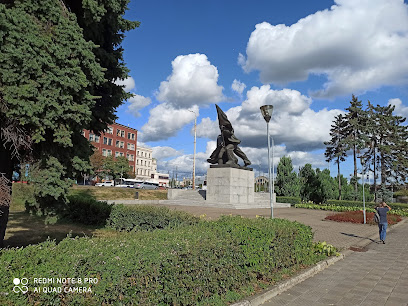
Donkey
Explore the enchanting Donkey attraction in Riga, where vibrant culture meets stunning architecture in the heart of Latvia's capital.

Barricades Memorial
Explore the Barricades Memorial in Riga, a significant historical landmark that honors Latvia's struggle for independence and resilience against oppression.

Coats of Arms of Latvian Municipalities Mural (LV100)
Explore the Coats of Arms of Latvian Municipalities Mural in Riga, a vibrant tribute to Latvia's rich cultural heritage and local identity.

Reconocimiento UNESCO al Centro Histórico de Riga
Explore the rich history and stunning architecture of Riga's UNESCO-listed Historical Center, a must-visit destination for culture lovers and adventurers.

Elizabetes iela 10B
Explore the architectural beauty and rich history of Elizabetes iela 10B, a captivating tourist attraction in the heart of Riga, Latvia.

Unmissable attractions to see
Bastejkalna Park
Explore the serene beauty of Bastejkalna Park in Riga, a vibrant urban oasis filled with lush greenery, historical monuments, and picturesque pathways.

St. Peter's Church
Explore the majestic St. Peter's Church in Riga, a Gothic masterpiece with breathtaking views and rich cultural significance, perfect for every tourist.

Riga Cathedral
Discover Riga Cathedral, a stunning blend of Gothic and Baroque architecture, and immerse yourself in Latvia's rich cultural heritage.
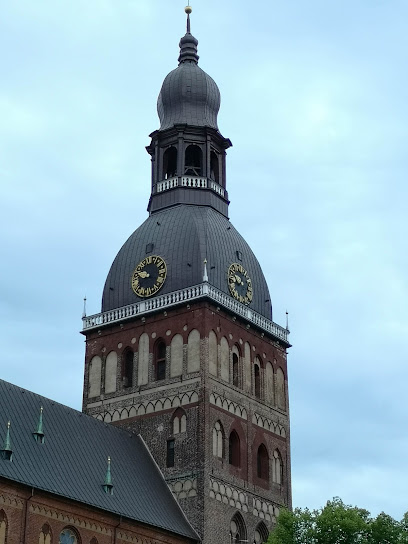
Cat House
Discover the charm of Riga at the Cat House, a unique tourist attraction featuring whimsical cat sculptures and rich local history.

Essential places to dine
Rozengrāls (Vinarium civitatis rigensis)
Discover Rozengrāls: A Medieval Culinary Experience in Riga's Heart - Savor Traditional Latvian Cuisine and Exquisite Wines.
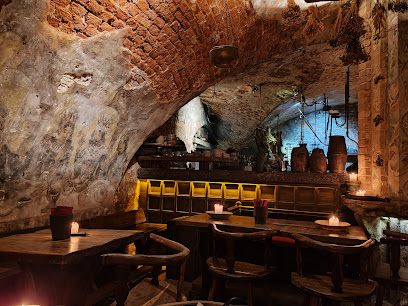
OGLE
Experience exquisite grilled cuisine at OGLE in Riga's Central District - where culinary artistry meets warm hospitality.

Casa Nostra Italian restaurant
Experience authentic Italian cuisine at Casa Nostra in Riga – where every dish tells a story of Italy's rich culinary heritage.

B Bārs Restorāns
Discover culinary excellence at B Bārs Restorāns in Riga - where local flavors meet innovative cuisine and vibrant cocktails.
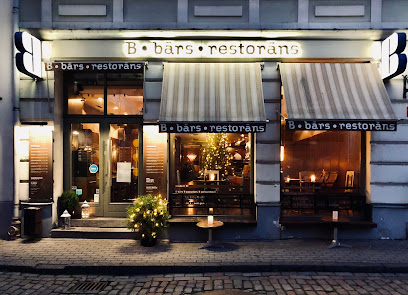
Key to Riga
Experience exquisite dining at Key to Riga - where local flavors meet international flair in a stunning Central District setting.

Kolonade. Our Stories...
Experience exquisite Latvian cuisine at Kolonade, where tradition meets modern elegance in the heart of Riga.

Zviedru vārti restaurant
Experience authentic Latvian cuisine at Zviedru vārti restaurant in Riga - where tradition meets modern culinary art.

Entresol
Discover the exquisite flavors of modern Latvian cuisine at Entresol in the heart of Riga, where culinary artistry meets elegance.

Salve Restaurant
Experience authentic Latvian cuisine at Salve Restaurant in Riga's Central District - where tradition meets flavor.

AKA Latvian Cuisine
Discover authentic Latvian cuisine at AKA Latvian Cuisine in Riga—where tradition meets modern flavor in every dish.

Markets, malls and hidden boutiques
Gallery Centre, Shopping mall
Discover the ultimate shopping experience at Gallery Centre in Riga, featuring diverse shops, delightful dining options, and a vibrant atmosphere.

Galleria Riga
Explore Galleria Riga: a vibrant shopping mall offering local and international brands, delicious dining, and exciting events in the heart of Latvia.
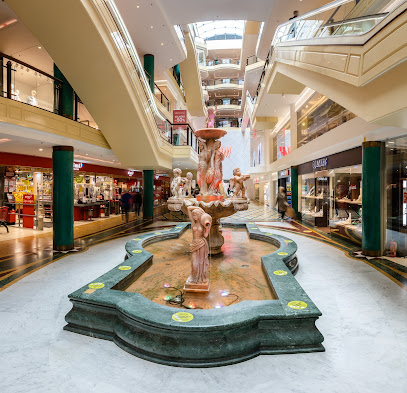
ELKOR Gift Shop suvenīru veikals
Explore the best of Latvian culture at ELKOR Gift Shop, where unique souvenirs and local crafts await every traveler in the heart of Riga.

Art Nouveau Rīga - Jūgendstila paviljons
Explore the enchanting world of Art Nouveau Rīga, where exquisite handcrafted gifts and rich cultural heritage await every visitor.

RIIJA
Discover unique and tasteful Latvian souvenirs at RIIJA, a charming store in the heart of Riga's Central District.

PODIUM Luxury fashion department store
Explore Podium Luxury Fashion Department Store in Riga for an exquisite selection of designer brands and a world-class shopping experience.

EKO SUVENĪRS Rīga -ECO SOUVENIR Riga
Explore the essence of Latvia at EKO SUVENĪRS Rīga, where unique, handcrafted souvenirs await every traveler.

Black Cat Souvenirs
Explore Black Cat Souvenirs for authentic Latvian gifts, handcrafted treasures, and a taste of local culture in the heart of Riga.
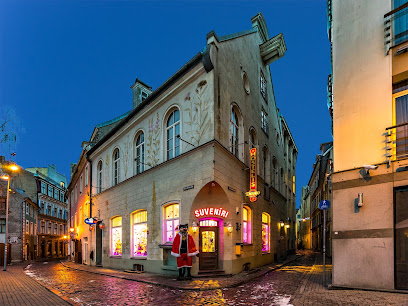
Gift shop Riga
Explore the essence of Latvia at Gift Shop Riga, where unique souvenirs and local crafts await your discovery.

Linen and Souvenirs
Explore Riga's Linen and Souvenirs shop for unique handicrafts and authentic Latvian gifts that capture the essence of local culture.

Essential bars & hidden hideouts
FUNNY FOX SPORTS, KARAOKE PUB/BAR
Funny Fox Sports Karaoke Pub/Bar: Your go-to spot for an unforgettable night of singing, drinks, and sports in the heart of Riga.

Black Magic
Discover the enchanting Black Magic in Riga, where exquisite chocolates and creative cocktails create a unique indulgent experience.

The Armoury Bar
Discover the charm of Riga at The Armoury Bar, where exquisite cocktails meet rich cultural history in a cozy setting.

Beer House No.1
Discover the heart of Latvian culture at Beer House No.1, where craft beers and hearty meals create unforgettable experiences.

Queens
Discover the lively ambiance and delightful local drinks at Queens Pub in Riga, the heart of Latvia's nightlife.
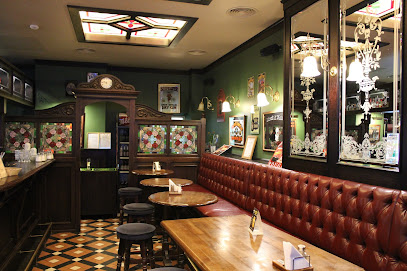
Victory Pub Riga
Discover the lively atmosphere of Victory Pub Riga, where local flavors meet vibrant nightlife in the heart of Latvia's capital.

This Place Doesn't Need A Name Šķūņu
Experience the unique charm of Riga at 'This Place Doesn't Need A Name'—a bar offering delightful cocktails and a cozy atmosphere for all.

D'vine bar
Discover the cozy charm of D'vine Bar in Riga's Central District, where exquisite cocktails and a warm atmosphere await.

Fly Bar, Cocktails And Shesha
Experience the vibrant nightlife of Riga at Fly Bar, where expertly crafted cocktails and shesha create the perfect atmosphere for relaxation and fun.

Gallery Bar at the Gallery Park Hotel & SPA
Discover the elegance of the Gallery Bar at the Gallery Park Hotel & SPA, where exquisite cocktails and a refined ambiance meet in the heart of Riga.

Local Phrases
-
- HelloSveiki
[svei-ki] - GoodbyeUz redzēšanos
[uz red-zē-ša-nos] - YesJā
[yā] - NoNē
[nē] - Please/You're welcomeLūdzu
[luu-dzu] - Thank youPaldies
[pal-dies] - Excuse me/SorryAtvainojiet
[at-vai-no-yiet] - How are you?Kā jums klājas?
[kaa yums klaa-yas] - Fine. And you?Labi. Un jums?
[la-bi. oon yums] - Do you speak English?Vai jūs runājat angļu valodā?
[vai yuus roo-naa-yat ang-lu va-lo-daa] - I don't understandEs nesaprotu
[es ne-sa-pro-tu]
- HelloSveiki
-
- I'd like to see the menu, pleaseEs vēlētos redzēt ēdienkarti, lūdzu
[es vee-le-tohs red-zeet ed-yen-kar-tee, luu-dzu] - I don't eat meatEs nēēdu gaļu
[es nee-doo ga-lu] - Cheers!Priekā!
[prie-kaa] - I would like to pay, pleaseEs vēlētos samaksāt, lūdzu
[es vee-le-tohs sa-mak-saat, luu-dzu]
- I'd like to see the menu, pleaseEs vēlētos redzēt ēdienkarti, lūdzu
-
- Help!Palīdzība!
[pa-liid-zee-ba] - Go away!Aiziet prom!
[ai-zi-et prom] - Call the Police!Zvaniet policiju!
[zva-niet po-li-tsi-yu] - Call a doctor!Zvaniet ārstu!
[zva-niet aar-stu] - I'm lostEs esmu pazudis
[es es-mu pa-zu-dis] - I'm illMan ir slikti
[man eer slikti]
- Help!Palīdzība!
-
- I'd like to buy...Es vēlētos iegādāties...
[es vee-le-tohs i-ya-gaa-da-ties] - I'm just lookingEs tikai skatos
[es ti-kai ska-tos] - How much is it?Cik tas maksā?
[tsik tas mak-saa] - That's too expensiveTas ir pārāk dārgs
[tas eer paa-raak daargs] - Can you lower the price?Vai jūs varat samazināt cenu?
[vai yuus va-rat sa-ma-zi-naat tse-nu]
- I'd like to buy...Es vēlētos iegādāties...
-
- What time is it?Cik ir pulkstenis?
[tsik eer pulk-ste-nis] - It's one o'clockIr viens pulkstenis
[eer vyeens pulk-ste-nis] - Half past (10)Pus desmit
[poos des-mit] - MorningRīts
[riits] - AfternoonPēcpusdiena
[pee-chpus-die-na] - EveningVakars
[va-kars] - YesterdayVakar
[va-kar] - TodayŠodien
[sho-die-en] - TomorrowRīt
[riit] - 1Viena
[vyena] - 2Divi
[dee-vee] - 3Trīs
[triis] - 4Četri
[che-tri] - 5Pieci
[pee-ee-tsi] - 6Seši
[se-shi] - 7Septiņi
[sep-ti-nee] - 8Astoņi
[as-toni] - 9Devini
[de-vee-nee] - 10Desmit
[des-mit]
- What time is it?Cik ir pulkstenis?
-
- Where's a/the...?Kur ir...?
[koor eer] - What's the address?Kāda ir adrese?
[kaa-da eer a-dre-se] - Can you show me (on the map)?Vai jūs varat man parādīt (uz kartes)?
[vai yuus va-rat man pa-raa-deet (ooz kar-tes)] - When's the next (bus)?Kad būs nākamais (autobuss)?
[kad boos naa-ka-mais (au-to-boos)] - A ticket (to ....)Biļete (uz ....)
[bi-ye-te (ooz)]
- Where's a/the...?Kur ir...?
History of Central District
-
The Central District of Riga, established in the 13th century, became integral to the Hanseatic League, a powerful trade alliance in Northern Europe. Riga's strategic position along the Daugava River facilitated trade routes, bringing prosperity and growth. The district's layout was heavily influenced by the architectural styles of the Hanseatic merchants, leading to the development of warehouses and merchant houses that characterized the area.
-
In the 18th and 19th centuries, the Central District underwent significant architectural transformation, showcasing Baroque and later Art Nouveau styles. The late 19th century saw Riga becoming a hub for Art Nouveau architecture, with over 800 buildings designed in this style. Notable examples include the Alberta iela, where the intricate facades reflect the artistic movements and cultural aspirations of the period.
-
The early 20th century was marked by a surge in Latvian nationalism. The Central District became a focal point for cultural and political movements, leading to Latvia's declaration of independence in 1918. Prominent buildings such as the National Theatre and the House of the Blackheads became symbols of national pride and cultural identity during this transformative period.
-
Following World War II, Riga was incorporated into the Soviet Union, leading to substantial changes in the Central District. Soviet urban planning principles were applied, resulting in the construction of large residential blocks and the reconfiguration of public spaces. Despite this, many historical buildings were preserved, creating a juxtaposition of Soviet-era architecture and earlier styles.
-
Since regaining independence in 1991, the Central District has experienced a cultural renaissance. Efforts to restore and preserve historical buildings have revitalized the area, attracting both locals and tourists. The establishment of cultural institutions, galleries, and cafes has transformed the Central District into a vibrant hub of creativity and social interaction, reflecting the dynamic spirit of modern Riga.
Central District Essentials
-
The Central District of Riga is easily accessible from other neighborhoods and the airport. From Riga International Airport, you can take bus number 22, which connects directly to the city center and the Central District. The journey takes about 30 minutes. If you are coming from other neighborhoods, trams and buses are frequent, with several lines running through the district. The main train station, Rīga Pasažieru, is also located on the edge of the Central District, providing easy access to regional and international trains.
-
Central District is well-connected and pedestrian-friendly. The public transport system includes trams, buses, and trolleybuses, with tickets available at kiosks or via mobile apps. Bicycles are a popular way to explore; rental services are available throughout the district. Walking is also encouraged, as many attractions are within a short distance. For those needing taxi services, both traditional taxis and ride-hailing apps operate efficiently in the area.
-
The Central District of Riga is generally safe for tourists, but standard precautions are advisable. Areas around the Central Market and the Old Town can be crowded, so keep an eye on belongings. While crime rates are low, petty theft can occur, particularly in busy tourist areas. It is advisable to avoid poorly lit streets at night and to be cautious in isolated areas, especially near the train station.
-
In case of an emergency, dial 112 for police, fire, or medical assistance. The main hospital in the Central District is the Pauls Stradiņš Clinical University Hospital, which provides emergency services. It is recommended to have travel insurance that covers medical emergencies. For less urgent health issues, local pharmacies are available for over-the-counter medications.
-
Fashion: Do dress comfortably but stylishly, as locals tend to dress well. Don't wear overly casual or beach attire in urban areas. Religion: Do be respectful when visiting churches and synagogues. Always dress modestly and be mindful of any photography restrictions. Public Transport: Do validate your ticket before boarding and be courteous. Don't eat or drink on public transport. Greetings: Do greet with a firm handshake. Avoid overly familiar gestures unless you know the person well. Eating & Drinking: Do try local delicacies and enjoy meals at traditional restaurants. Don't refuse food or drink offered by locals, as it may be seen as impolite.
-
To experience Central District like a local, visit the local markets and cafés where traditional Latvian dishes are served. Engage with local artists and craftsmen at the Kalnciema Quarter, especially during weekend markets. Take a leisurely stroll through the Art Nouveau district, known for its stunning architecture, or relax in one of the many parks. For a unique experience, try to catch a live performance at the Latvian National Opera or explore the hidden courtyards and art installations throughout the neighborhood.
Trending Landmarks in Central District
Nearby Cities to Central District
-
Things To Do in Jurmala
-
Things To Do in Sigulda
-
Things To Do in Cesis
-
Things To Do in Talsi
-
Things To Do in Šiauliai
-
Things To Do in Kuldiga
-
Things To Do in Panevėžys
-
Things To Do in Valga
-
Things To Do in Ventspils
-
Things To Do in Pärnu
-
Things To Do in Kuressaare
-
Things To Do in Viljandi
-
Things To Do in Utena
-
Things To Do in Daugavpils
-
Things To Do in Liepaja













